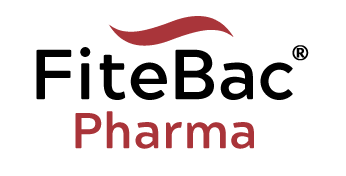FiteBac Pharma
FiteBac Technology/FiteBac Pharma's innovations stem from the work of numerous international academic research scientists. FiteBac Pharma K21 is the blockbuster antimicrobial small molecule designed to modulate biological, immunological, and metabolic systems for treating a wide range of infectious and inflammatory diseases. This patented drug substance has demonstrated the ability to safely eliminate bacterial, fungal, and viral infections, enhance innate immunity, induce mitophagy while improving mitochondrial and cellular metabolism, accelerate wound healing, and even promote the development of zebrafish and chickens, leading to increased adult mass. Rigorous research from Dr. Bhupesh Prusty's laboratory and Dr Christopher Rongo's laboratory is focused on various aspects of mitochondrial remodeling and reprograming, as well as mitochondrial-to-nuclear signaling with K21. FiteBac K21 uniquely targets the underlying disease state, given that most diseases involve microbial-associated inflammation and mitochondrial dysfunction.
FiteBac Pharma is currently seeking investment
FiteBac Pharma is seeking a series-a investment in the range of 1m-5m
What We Do
FiteBac K21 provide antimicrobial and tissue regeneration drug for wound closures, wound dressings, orthopedic devices all Class I,II,III devices.
K21 drug sepsis recovery
FiteBac Pharma investigation and collaboration with Walter Reed Army Institute of Research (WRAIR) for K21 as prophylaxis and therapeutic for sepsis
K21 antimicrobial as drug preservative
K21 positioned as drug preservative for vaccines, drug products, blood products
A proprietary antimicrobial molecule positioned with FDA IND applications as topical rub and treatment of wounds and burn care. K21 positioned for wound irrigation, oral rinse, intranasal, inhalation, ophthalmic
K21 increases viability of fertilized zebrafish eggs, accelerates zebrafish development and growth, enhances visual acuity and cognitive function with increased adult mass.
An FDA-cleared dental cavity cleanser containing K21 QAS, designed to clear restoration sites of carious debris and reduce the presence of bacteria and fungi, helping to stabilize collagen fibers and prevent restoration failure
Application Area
Show LessDrugs
FDA Regulated Medical Devices
Biologics
Key People
News & Updates
Research article detailing the mechanism by which quaternary ammonium silane compounds disrupt bacterial membranes and biofilms.
Clinical trial evaluating the antimicrobial efficacy of QAMS-containing orthodontic acrylic resin in vivo.
Study on the antiviral properties of K21 against herpes viruses.
Study demonstrating the antifungal efficacy of K21 against fluconazole-resistant Candida species.
Anti-viral Activity of Quaternary Ammonium Silane (K21) Against HHV-6A and HHV-7
The antiviral compound K21, a quaternary ammonium silane, demonstrates significant inhibitory effects against HHV-6A and HHV-7 in vitro. While also showing some activity against HSV-1, K21 is considerably more potent against HHV-6A and HHV-7. This suggests a potential role for K21 in treating infections caused by these viruses
Study showing that K21 inhibits replication of a broad range of viruses, including both enveloped and non-enveloped DNA and RNA viruses.K21 has been shown to inhibit the replication of a wide range of viruses, including both enveloped viruses (like HSV-1, HHV-6, HHV-7, and influenza A) and non-enveloped viruses (like phage MS2 and feline norovirus)
FiteBac K21 coated Ethicon Monocryl suture conferred antibacterial action properties without compromising the physical and mechanical properties of the suture.
K21 increases viability of fertilized zebrafish eggs, accelerates zebrafish development and growth, enhances visual acuity and cognitive function with increased adult mass.
To analyze function of new K21 molecule in the invasive process of oral squamous cell carcinoma (OSCC) cell line.
A Comparison of Miniscrew Stability and Peri-implant Inflammation When Precoated With Antimicrobial Quaternary Ammonium Compound K21 vs Ethanol Control in Orthodontic Patients: a Triple-blind, Split-mouth, Randomized Controlled Clinical Trial
Multiple Patents Awarded in U.S., EU, China, Hong Kong
FiteBac (Kimmerling Holdings Group) holds multiple patents for its antimicrobial technology across major global markets.
Trademarked in U.S., EU, China, India, Brazil
The FiteBac (Kimmerling Holdings Group) name and logo are trademarked in several key international markets.
New antivirals are required to prevent rising antimicrobial resistance from replication inhibitors. The aim of this study was to analyse the range of emerging mutations in herpesvirus by whole genome deep sequencing. We tested human herpesvirus 6 treatment with novel antiviral K21, where evidence indicated distinct effects on virus envelope proteins. We treated BACmid cloned virus in order to analyse mechanisms and candidate targets for resistance. Illumina based next generation sequencing technology enabled analyses of mutations in 85 genes to depths of 10,000 per base detecting low prevalent minority variants (<1%). After four passages in tissue culture the untreated virus accumulated mutations in infected cells giving an emerging mixed population (45–73%) of non-synonymous SNPs in six genes including two envelope glycoproteins. Strikingly, treatment with K21 did not accumulate the passage mutations; instead a high frequency mutation was selected in envelope protein gQ2, part of the gH/gL complex essential for herpesvirus infection. This introduced a stop codon encoding a truncation mutation previously observed in increased virion production. There was reduced detection of the glycoprotein complex in infected cells. This supports a novel pathway for K21 targeting virion envelopes distinct from replication inhibition.
